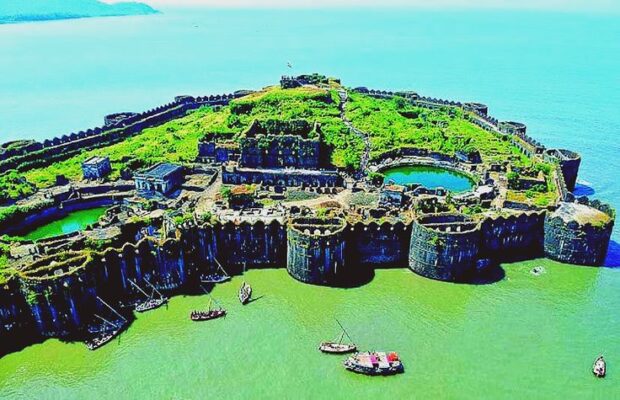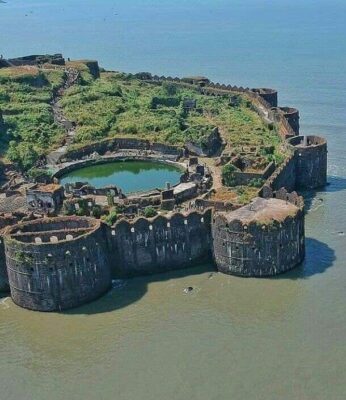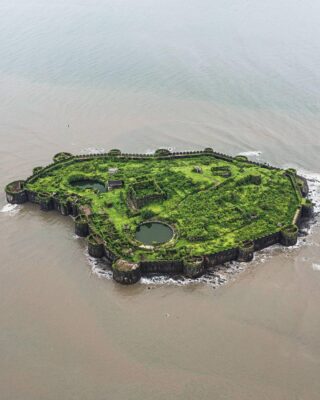Janjira Fort, located off the coast of Murud in Maharashtra, India, is a remarkable testament to ancient engineering and military strategy. Known as the “undefeated fort,” this impregnable structure withstood countless attacks by the British, Portuguese, and Marathas, solidifying its place in history as one of India’s most resilient maritime forts. Follow archeology.dulichvn.net to discover many hidden mysteries that have yet to be discovered.

The History of Janjira Fort: A Timeless Marvel of Strength and Strategy
Origins of the Invincible Fortress
Constructed during the late 15th century by the Siddis of Janjira, the fort was designed with strategic foresight to counter sea invasions. Perched on an island off the coast of Maharashtra, it was surrounded on all sides by the Arabian Sea, making it nearly impenetrable. The fort’s name, Janjira, is derived from the Arabic term “Jazeera,” which means “island,” aptly capturing its geographic essence.
The fort’s design reflected advanced military engineering of its time. Accessible only by boat, its towering walls were constructed to withstand the force of cannonballs, while its location allowed for a panoramic view of approaching enemies. Inside, it housed a complex network of rooms, secret passages, and armories, showcasing its role as a formidable bastion of defense.
The Unbroken Legacy of Resistance
Janjira Fort earned its reputation as the “undefeated fort” through its remarkable history of resilience. Over the centuries, it withstood countless sieges by powerful adversaries, including the Portuguese, the Dutch, and the Marathas. Despite these persistent assaults, no enemy force ever succeeded in breaching its walls.
This unbroken record of defense was no accident. The Siddis, renowned for their naval prowess, meticulously maintained the fort and ensured it remained well-stocked with provisions and ammunition. The fort’s cannons, many of which remain preserved to this day, played a critical role in repelling invaders. Among these, the colossal cannon Kalal Bangdi stands as a symbol of the fort’s indomitable spirit.

Cultural Significance and Architectural Heritage
Strategic Features of Janjira Fort
Janjira Fort is not only an architectural marvel but also a strategic masterpiece, showcasing brilliant military tactics and defense mechanisms. Every aspect of its design was created with the aim of ensuring it could withstand any enemy assault, establishing it as one of the most formidable fortresses in history. The strategic features of the fort reflect the ingenuity and military prowess of its creators, making it a symbol of resilience and strength.
Ingenious Defensive Design
The design of Janjira Fort is a prime example of military strategy at its best. With 22 rounded bastions, each armed with a variety of cannons, the fort was able to provide an unparalleled defense against naval attacks. These bastions were strategically placed to offer clear views of the surrounding seas, enabling defenders to spot and counter enemy movements long before they could approach the fort.
The fort’s high, thick walls were constructed to endure heavy bombardment and provided a formidable defense against both land and sea assaults. The height of the walls and their robust construction made it almost impossible for attackers to breach the fort’s defenses. These features contributed to Janjira Fort earning the title of the “undefeated fort,” as it never fell despite numerous attempts at siege throughout its history.
Mysterious Secret Passages
One of the most captivating aspects of Janjira Fort is the legend of its secret passages. According to local folklore, there are underwater tunnels that supposedly connected the fort to nearby villages. These secret passages are believed to have served as escape routes for the fort’s defenders or as supply lines during extended sieges, ensuring the fort could survive long periods of isolation.
While there is no definitive evidence to prove the existence of these underwater tunnels, the tales of these hidden routes continue to intrigue historians and visitors alike. The mystery surrounding the tunnels adds an element of intrigue to the fort’s already impressive defenses, further enhancing its reputation as an enigmatic and virtually impenetrable stronghold.
The Freshwater Lake: A Marvel in the Sea
Among the most remarkable features of Janjira Fort is its freshwater lake, which stands as an anomaly in the middle of the surrounding saltwater sea. This freshwater lake is not only a natural wonder but also a critical resource that ensured the fort’s survival during long sieges. With the surrounding waters being saltwater, the freshwater lake provided the fort’s defenders with a continuous, reliable water supply, which gave them a significant advantage over any attackers who would have struggled with limited freshwater access.
The presence of this freshwater lake is a testament to the fort’s self-sufficiency and strategic foresight. It was one of the many features that contributed to the fort’s reputation as a nearly invincible stronghold, as it allowed the defenders to withstand prolonged periods of siege without facing the common problem of water shortages.

Exploring Janjira Fort Today
Architectural Splendor
The architecture of Janjira Fort is truly awe-inspiring. As visitors approach, they are greeted by a grand entrance gate, which is beautifully adorned with intricate carvings and fine stonework. This gate sets the tone for the magnificence that lies within the fort. Beyond the entrance, the fort is equipped with 22 rounded bastions, each one strategically placed to offer clear sightlines for defense and commanding views of the surrounding sea. These bastions, some still equipped with cannons, stand as silent sentinels of the fort’s historical significance, having endured centuries of weather and warfare.
The fort’s thick, high walls are a remarkable feat of engineering. Made of solid stone, they have withstood the harsh coastal climate and enemy attacks for centuries. The defensive design of the fort is both formidable and beautiful, offering visitors the chance to marvel at the strength and precision of its construction. Walking along the fort’s ramparts allows visitors to imagine what it must have been like to defend such an imposing stronghold and to appreciate the stunning views over the Arabian Sea.
Historical Artifacts
Inside Janjira Fort, visitors can explore a variety of ancient structures that offer fascinating glimpses into the lives of its former inhabitants. The ruins of palaces, mosques, and military buildings tell the story of the Siddis of Janjira, the community that once occupied and defended the fort. The architectural details, including intricately designed arches and decorative stonework, reflect the cultural blend of Indian and African influences that characterized the Siddis’ reign.
Perhaps the most captivating historical artifacts are the old cannons scattered throughout the fort. These weapons, which were once used to defend the fort against invaders, remain in remarkable condition and are a powerful reminder of the fort’s military significance. Many of these cannons are still strategically positioned at the bastions, where they would have been used to repel naval attacks. For visitors interested in military history, these cannons offer a tangible connection to the fort’s strategic importance.
In addition to the cannons, visitors can find inscriptions and carvings on the fort’s walls. These ancient markings provide insights into the fort’s history, offering clues about the lives of the Siddis and their strategic thinking in defending the fort. The inscriptions are an important part of Janjira Fort’s legacy, helping to preserve the stories of its past inhabitants.
Scenic Views and Accessibility
Janjira Fort’s location, perched on an island in the Arabian Sea, offers some of the most breathtaking views in the region. From almost every vantage point within the fort, visitors are treated to stunning panoramas of the coastline and the azure waters surrounding the island. The fort’s elevated position makes it an ideal spot for watching the sunset, enjoying the peaceful expanse of the sea, or simply taking in the natural beauty of the area.
The scenic views of the Arabian Sea, combined with the imposing architecture of the fort, make it a popular destination for photographers. The combination of history, architecture, and nature provides the perfect backdrop for creating lasting memories.
Visiting Janjira Fort is an adventure in itself. The fort is accessible by a short ferry ride from the town of Murud, which adds an element of excitement to the trip. The journey across the sea gives visitors a chance to appreciate the fort’s strategic location and allows them to see the fort’s impressive structure from a distance. Once at the fort, visitors can explore its bastions, pathways, and ancient buildings, immersing themselves in its history and beauty.

Legacy and Significance of Janjira Fort
A Monument to Enduring Strength and Resilience
Janjira Fort is much more than just a historical structure; it is an enduring symbol of resilience and the strength of the human spirit. Throughout its long and storied history, the fort has stood as an unwavering monument to the ingenuity, strategic brilliance, and determination of the Siddis, who constructed it in the 15th century. Its unmatched ability to withstand numerous sieges and attacks, earning the title of the “undefeated fort,” speaks volumes about the skill and foresight of its builders. More than just a defensive structure, the fort represents the triumph of human will and cleverness against overwhelming odds, making it an iconic part of India’s maritime heritage.
The fort’s incredible resilience against enemies, storms, and time itself serves as a testament to the resourcefulness and resilience of ancient civilizations. It’s a physical embodiment of how communities, faced with adversity, find innovative solutions to ensure their survival and protect their people. For modern generations, Janjira Fort stands as an inspiring legacy—a reminder of the power of ingenuity, persistence, and the will to overcome even the most challenging circumstances.
A Source of Inspiration for Future Generations
Janjira Fort not only serves as a source of historical and cultural pride but also provides invaluable lessons for future generations. Its remarkable history serves as a constant source of inspiration for all those who study its existence. The fort’s history of resistance and survival sparks admiration for the strategic thinking and problem-solving abilities of ancient civilizations, particularly in their use of natural resources, advanced architectural designs, and military ingenuity. By understanding the fort’s story, we gain insight into the mindset of its builders and the tremendous efforts they put into ensuring its endurance over centuries.
The fort is also a reflection of the adaptability and resilience of its people. It highlights the ways in which ancient civilizations, armed with limited resources and technology, were able to rise to the occasion and safeguard their homes and families. Today, Janjira Fort serves as an inspiration for those who face challenges, reminding us of the importance of perseverance, creativity, and community in the face of adversity. For the youth and future generations, the fort’s story offers a profound message of hope, resilience, and the power of human determination.
Preserving a Cultural Treasure for Posterity
As one of the most significant historical landmarks in India, Janjira Fort is more than just a relic of the past—it is a vital part of the country’s cultural and historical legacy. Efforts are ongoing to preserve this magnificent fort, ensuring that its stories and lessons are passed down to future generations. Preservation of the fort is crucial not only for maintaining its architectural splendor but also for safeguarding the historical narratives that it holds. With each passing year, efforts by the government and various preservation groups aim to keep the fort intact for the enjoyment, education, and inspiration of those who come after us.
The fort continues to attract historians, researchers, and tourists from all over the world who come to explore its history, learn from its past, and appreciate the rich cultural tapestry it represents. In addition to serving as a popular tourist destination, Janjira Fort plays a crucial role in the study of India’s maritime history, military strategy, and cultural evolution. Its importance extends beyond its walls and into the very fabric of Indian heritage.
See more: John Candy and Dan Aykroyd: A Legendary Pair on the Set of The Great Outdoors (1987)
Conclusion
Janjira Fort is more than just a historic structure; it is a symbol of ingenuity, resilience, and undefeated legacy. With its strategic design, mysterious legends, and unparalleled defense, the fort remains an enduring enigma of Indian maritime history. Whether you’re a history buff, a cultural enthusiast, or an adventurer, Janjira Fort offers a journey into the past that is as fascinating as it is inspiring.


CÁC TIN KHÁC
Mary Walton: The Forgotten Inventor Who Helped Clean Up America’s Cities
Tomb of Queen Nefertari in the Valley of the Queens, Egypt
Discover the Hypostyle Hall of the Temple of Hathor at Dendera
Venus de Losange: Unveiling the Mystery of a 20,000-Year-Old Paleolithic Icon